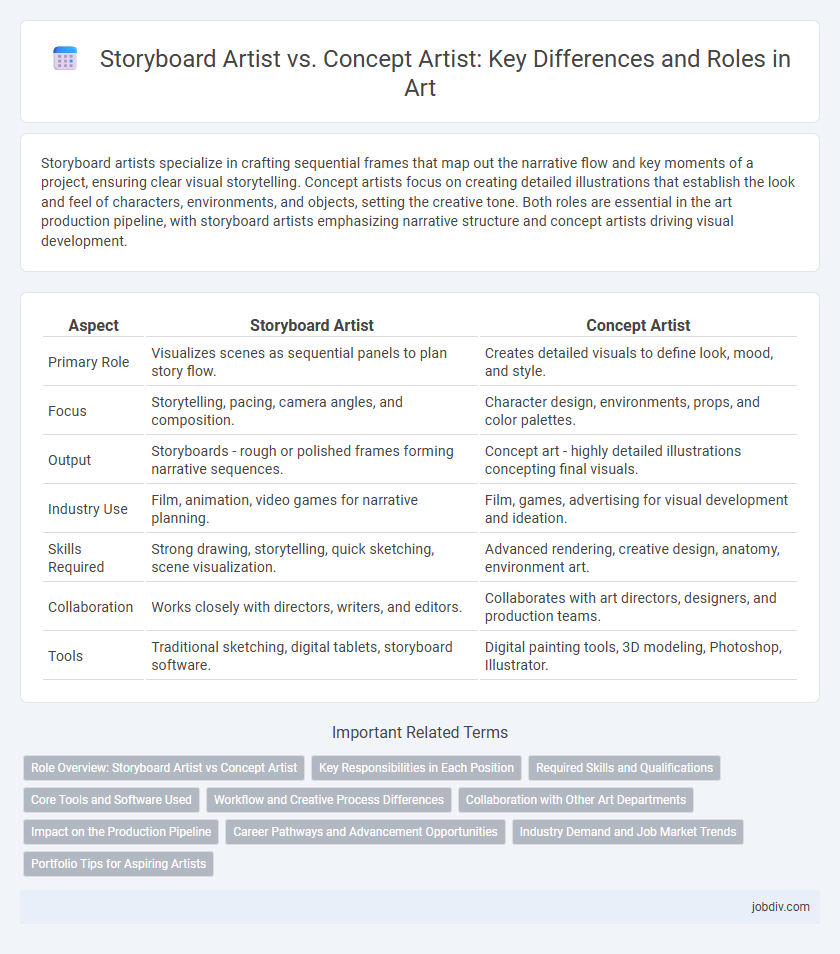Storyboard artists specialize in crafting sequential frames that map out the narrative flow and key moments of a project, ensuring clear visual storytelling. Concept artists focus on creating detailed illustrations that establish the look and feel of characters, environments, and objects, setting the creative tone. Both roles are essential in the art production pipeline, with storyboard artists emphasizing narrative structure and concept artists driving visual development.
Table of Comparison
| Aspect | Storyboard Artist | Concept Artist |
|---|---|---|
| Primary Role | Visualizes scenes as sequential panels to plan story flow. | Creates detailed visuals to define look, mood, and style. |
| Focus | Storytelling, pacing, camera angles, and composition. | Character design, environments, props, and color palettes. |
| Output | Storyboards - rough or polished frames forming narrative sequences. | Concept art - highly detailed illustrations concepting final visuals. |
| Industry Use | Film, animation, video games for narrative planning. | Film, games, advertising for visual development and ideation. |
| Skills Required | Strong drawing, storytelling, quick sketching, scene visualization. | Advanced rendering, creative design, anatomy, environment art. |
| Collaboration | Works closely with directors, writers, and editors. | Collaborates with art directors, designers, and production teams. |
| Tools | Traditional sketching, digital tablets, storyboard software. | Digital painting tools, 3D modeling, Photoshop, Illustrator. |
Role Overview: Storyboard Artist vs Concept Artist
Storyboard artists visualize narrative sequences by creating detailed panels that map out scenes and camera angles, ensuring coherent storytelling for films, animations, or commercials. Concept artists develop original character designs, environments, and props that establish the visual tone and style, serving as a reference for production teams. Both roles are essential in pre-production, with storyboard artists emphasizing narrative flow and concept artists focusing on creative ideation.
Key Responsibilities in Each Position
Storyboard artists visualize narratives by creating sequential illustrations that define scene composition, character actions, and camera angles, ensuring coherent storytelling in film, animation, or video games. Concept artists develop detailed visual representations of characters, environments, and props, establishing the artistic style and mood to guide production design. Both roles require strong drawing skills but differ in focus: storyboard artists emphasize narrative flow, while concept artists concentrate on creative exploration and design development.
Required Skills and Qualifications
Storyboard artists require strong skills in sequential storytelling, composition, and timing to effectively visualize scripts and direct scenes. Concept artists focus on creative design, anatomy, color theory, and environmental rendering to develop visual ideas for characters, settings, and props. Both roles demand proficiency in digital illustration tools such as Adobe Photoshop and strong artistic fundamentals, but storyboard artists emphasize narrative flow while concept artists prioritize original design and visual development.
Core Tools and Software Used
Storyboard artists primarily use tools like Adobe Photoshop, Toon Boom Storyboard Pro, and Clip Studio Paint to create sequential frames that visualize narrative flow. Concept artists rely heavily on software such as Adobe Photoshop, Corel Painter, and Procreate for designing detailed characters, environments, and props that establish the visual style of a project. Both roles require proficiency in digital drawing tablets like Wacom or iPad Pro to efficiently produce high-quality digital artwork.
Workflow and Creative Process Differences
Storyboard artists focus on visualizing key scenes and narrative flow by breaking down scripts into sequential frames, emphasizing timing and camera angles. Concept artists develop detailed, standalone images to establish the overall look, mood, and design of characters, environments, and props, often using iterative sketches and digital painting techniques. The storyboard workflow prioritizes storytelling clarity and pacing, while concept art centers on exploration and refinement of visual ideas to guide production design.
Collaboration with Other Art Departments
Storyboard artists collaborate closely with concept artists to visualize narrative sequences and ensure cohesive storytelling across art departments. Concept artists provide detailed environment and character designs that guide storyboard artists in framing scenes and composing shots. Effective communication between these roles streamlines the creative process and aligns visual development with the project's artistic vision.
Impact on the Production Pipeline
Storyboard artists play a crucial role in the production pipeline by visualizing the script and planning the sequence of shots, which streamlines the directing and editing processes. Concept artists focus on creating detailed and imaginative designs of characters, environments, and props, directly influencing the visual style and aesthetic direction. Together, their work ensures cohesive storytelling and efficient production by aligning narrative flow with visual development.
Career Pathways and Advancement Opportunities
Storyboard artists specialize in visual storytelling by creating sequential illustrations that map out scenes for films, animations, and commercials, often advancing to roles like lead storyboard artist or director of visual development. Concept artists focus on designing characters, environments, and props that establish the visual style of a project, with career growth leading to senior concept artist or art director positions. Both career paths offer advancement through building strong portfolios and gaining experience in collaborative production environments within the entertainment industry.
Industry Demand and Job Market Trends
Storyboard artists are crucial in pre-production, translating scripts into visual narratives, with steady demand in film, television, and animation sectors. Concept artists hold a key role in defining the aesthetic direction, especially in video games and film, experiencing significant growth due to expanding digital entertainment markets. Both professions demonstrate strong job market trends, but concept artists often command higher demand due to their influence on early design and branding stages.
Portfolio Tips for Aspiring Artists
Storyboard artists should showcase sequential art skills, clear narrative flow, and character expressions that convey emotion effectively, while concept artists must emphasize originality, detailed environment designs, and diverse character concepts. A strong storyboard portfolio includes completed sequences that demonstrate timing, camera angles, and visual storytelling techniques, whereas a concept portfolio benefits from varied thumbnails, color studies, and polished final renders that highlight creativity and design thinking. Aspiring artists must tailor their portfolios to their target role by prioritizing relevant skills and presenting work that aligns with industry standards and project requirements.
Storyboard Artist vs Concept Artist Infographic

 jobdiv.com
jobdiv.com